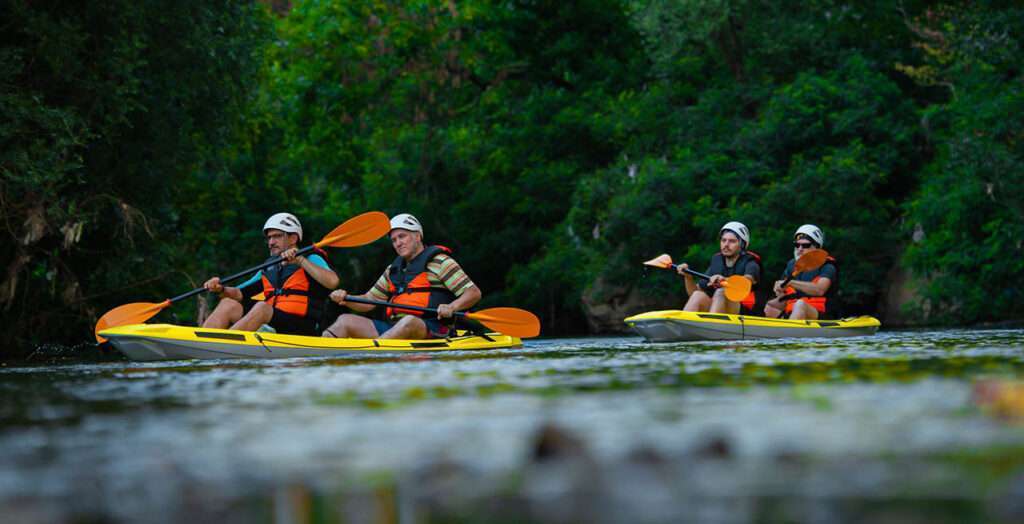Imagine the gentle plop of your paddle dipping into the serene water, the thrill of a sudden gust of wind, and the vibrant lullaby of nature surrounding you. These delights of kayaking can, however, be clouded by an unexpected, dreaded splash – your paddle sinking into the depths.
Countless paddlers each year find themselves in a pickle, stuck in the water without a paddle. Literally. An essential preventive measure is employing a simple tool: the paddle leash. It’s a safety net in the unsteady waters, tethering your paddle to your kayak, ensuring it doesn’t part ways in case of mishaps. For anyone venturing onto the water, it’s a no-brainer.
Different Types of Kayak Paddle Leashes
Like the satisfying snap, crackle, and pop of breakfast cereal, there are different kinds of paddle leashes, each with unique features.
The first type, coiled paddle leashes, reminiscent of old-school telephone cords, are compact and minimize the risk of tangling. They are stretchy and give you enough room to maneuver your paddle without feeling restrained.
Secondly, straight paddle leashes, like an unwavering arrow’s flight, are straightforward and reliable. They usually have a fixed length, reducing the risk of snapping back.
Finally, rod leashes, more versatile than the others, can also be used to secure fishing rods or other equipment to your kayak, proving to be as versatile as a Swiss Army Knife.
Step-by-Step Guide to Attaching a Leash to Your Kayak Paddle
Securing a leash to your paddle is as easy as pie. Follow these steps, and you’ll have your paddle and kayak linked in no time.
01. Choose the Paddle’s Attachment Point
The first step in this procedure is deciding where on the paddle you will attach the leash. This is typically towards the middle of the shaft. Placing it in the middle ensures balance and doesn’t interfere with your paddling action.
Once you’ve found the sweet spot, it’s time to connect. Wrap the velcro strap or fastener of the leash around the shaft at the chosen point.
If the leash comes with a tie-string, simply thread it through the hole in the shaft, tie a robust knot and ensure it’s secure.
02. Identify the Kayak’s Attachment Point
Next, turn your attention to the kayak. You need to locate a fitting point of attachment on it. This could be a pad eye, a cleat, or any other secure fixture on the deck. If your kayak lacks an appropriate point, you may need to install a pad eye or an accessory mount, which can be as thrilling as embarking on a mini DIY project.
Make sure this point is within reach but won’t obstruct your movement while paddling, akin to placing a chess piece strategically on the board.
03. Secure the Leash to the Kayak
With the kayak’s attachment point selected, it’s time to connect the dots. Attach the other end of the leash to the chosen spot on your kayak. This is generally done through a clip or a carabiner.
As you secure the connection, envision it as a handshake between the paddle and the kayak – a firm, robust grip that assures neither will part ways in the face of a challenge.
Always double-check to make sure the attachment is solid and won’t be easily dislodged during your journey.
04. Final Inspection
And there you have it! Your paddle is now securely tethered to your kayak, ready to ride the waves like a pair of seagulls soaring in unison.
However, before you hit the water, do a final once-over. Make sure the leash does not interfere with your paddling, the connections are tight, and the leash is clear of any potential snagging hazards. After all, a stitch in time saves nine, and this final check might save your paddle from an unexpected departure.
Key Considerations When Using a Paddle Leash
While a paddle leash is a boon in most situations, there can be circumstances where it acts more like a fly in the ointment. In rapid rivers or rough whitewater, a paddle leash can be a liability, snagging on underwater obstacles, or potentially causing entanglement. In such scenarios, a quick-release mechanism on the leash can be a lifesaver.
The leash length also warrants consideration. A leash that is too long can become a trip hazard, while a very short leash might limit maneuverability. Striking a balance is key, much like finding the sweet spot in a game of baseball.
The Upshot
A kayak paddle leash can be a paddle-saver, keeping your oar close and your spirits high. It’s an invaluable tool for peace of mind, especially for beginners who are getting their feet wet or seasoned kayakers venturing into choppier waters.
Think of it as a faithful dog – always by your side, eager to help when you’re in a bind. A paddle leash keeps you connected to your essential equipment, ensuring your kayaking trip doesn’t lose its paddle or its charm.
Anchoring your adventure is not merely about attaching a leash to a paddle; it’s about embracing the harmony between you, your gear, and the environment, setting the stage for many memorable escapades on the water. Happy kayaking!

